Harmonized Pan-European Time Series for Monitoring Soil Sealing
Abstract
:1. Introduction
2. Data
2.1. Available Soil Sealing Geospatial Data Layers
2.1.1. CLMS Imperviousness Degree Layers
- A simple layer mapping the percentage of sealing increase or decrease for those pixels that show sealing change during the period covered. This product is available in 20 m and 100 m pixel sizes.
- A classified change product that maps the most relevant categories of sealing change (no sealing, new cover, loss of cover, unchanged sealed, increased sealing, decreased sealing). This product is available in the 20 m pixel size only.
2.1.2. CLMS CLC+ Backbone Layer
2.2. Reference Data
2.2.1. Sample Design and Stratification
- 1.1.1 = continuous urban fabric;
- 1.1.2 = discontinuous urban fabric;
- 1.2.1 = industrial, commercial areas;
- 1.2.3 = ports;
- 1.2.4 = airports.
- Stratum 1, commission status strata, where the imperviousness degree is between 1 and 100% in the 2015 layer.
- Stratum 2, High-Probability Omission strata, where the imperviousness degree is 0% in the 2015 reference year but where the Open Street Map and the traditional CLC 2015 layers indicate “impervious classes”.
- Stratum 3, Low-Probability Omission strata covering the rest of the area.
- Stratum 4, commission Change Strata with all changes between 2006–2009, 2009–2012, 2012–2015 and 2015–2018 [gain, loss, increased and decreased were combined due to the very small area covered].
2.2.2. Response Design
- Minimum Mapping Unit (MMU);
- Minimum Mapping Width (MMW);
- Class definition (what is an impervious surface?);
- Ensure that the image data used are as close as possible temporally to that used for the map production.
3. Methods
3.1. Accuracy Assessment
3.2. Harmonization of Sealing Layers
3.2.1. Biased and Unbiased Area Estimates
3.2.2. Harmonization Approach
- Step 1—Calculating the areas of gain for each of the 91 combinations of production/bioregions:
- Step 2—Discriminating function to separate actual gain from omission from previous periods.
- Step 3—Production of revised sealed 100 m spatial resolution time series 2006–2018:
- The reclassified vector IMCC1518 layer is rasterized as a 10 m layer, only keeping values classified as ‘actual sealing’ gains.
- This new sealing gain layer is combined with the losses and stable areas from the original IMCC1518 layer at 10 m to create a revised IMCC1518 layer.
- Gain areas are removed from and losses added to the binary sealed layer derived from the CLC+ BB sealed 2018 10 m layer to create a new revised 2015 status layer.
- Subsequent status layers for year n (e.g., year 2012) are produced from combining the status layer from the consecutive year (e.g., 2015) with the corresponding IMCC layer (e.g., IMCC 2012–2015) at 10 m resolution.
- All 10 m layers are aggregated to 100 m spatial resolution, thus producing the harmonized dataset.
4. Results and Discussion
4.1. Validation of Status and Change Layers
4.2. Change Area Estimation
5. Conclusions and Recommendations
- The level of omission errors is reduced for all status layers.
- The level of commission errors is slightly increased but remains low and at a similar level to the level of omission errors, meaning that area statistics as extracted from the datasets should be close to reality, which was not the case previously.
- The discontinuity in the time series between 2015 and 2018 is now resolved with changes in line with the expected level of increase over EEA38 + UK.
Author Contributions
Funding
Data Availability Statement
Conflicts of Interest
References
- European Commission. Proposal for a Directive of the European Parliament and the Council on Soil Monitoring and Resilience (Soil Monitoring Law). COM(2023) 416 Final; European Commission: Brussels, Belgium, 2023. [Google Scholar]
- European Commission; Eurostat. LUCAS—Land Use and Land Cover Survey. 2023. Available online: https://ec.europa.eu/eurostat/statistics-explained/index.php?title=LUCAS_-_Land_use_and_land_cover_survey (accessed on 28 May 2024).
- European Environment Agency. CLC+ Backbone 2018 (raster 10 m), Europe, 3-yearly. February 2023. Available online: https://doi.org/10.2909/cd534ebf-f553-42f0-9ac1-62c1dc36d32c (accessed on 28 May 2024).
- European Environment Agency. Imperviousness Density 2018 (raster 100 m), Europe, 3-yearly. August 2020. Available online: https://doi.org/10.2909/524fa72f-61d7-4364-801e-3e271d7b10bc (accessed on 28 May 2024).
- Pesaresi, M.; Guo, H.; Blaes, X.; Ehrlich, D.; Ferri, S.; Gueguen, L.; Halkia, M.; Kauffmann, M.; Kemper, T.; Lu, L.; et al. A Global Human Settlement Layer From Optical HR/VHR RS Data: Concept and First Results. IEEE J. Sel. Top. Appl. Earth Obs. Remote Sens. 2013, 6, 2102–2131. [Google Scholar] [CrossRef]
- Marconcini, M.; Metz-Marconcini, A.; Üreyen, S.; Palacios-Lopez, D.; Hanke, W.; Bachofer, F.; Zeidler, J.; Esch, T.; Gorelick, N.; Kakarla, A.; et al. Outlining where humans live, the World Settlement Footprint 2015. Sci. Data 2020, 7, 242. [Google Scholar] [CrossRef] [PubMed]
- Waldner, F.; Defourny, P. Where can pixel counting area estimates meet user-defined accuracy requirements? Int. J. Appl. Earth Obs. Geoinf. 2017, 60, 1–10. [Google Scholar] [CrossRef]
- Olofsson, P.; Foody, G.M.; Herold, M.; Stehman, S.V.; Woodcock, C.E.; Wulder, M.A. Good practices for estimating area and assessing accuracy of land change. Remote Sens. Environ. 2014, 148, 42–57. [Google Scholar] [CrossRef]
- McRoberts, R.E. Satellite image-based maps: Scientific inference or pretty pictures? Remote Sens. Environ. 2011, 115, 715–724. [Google Scholar] [CrossRef]
- Gallego, J. Remote sensing and land cover area estimation. Int. J. Remote Sens. 2004, 25, 3019–3047. [Google Scholar] [CrossRef]
- Sannier, C.; Gallego, J.; Dahmer, J.; Smith, G.; Dufourmont, H.; Pennec, A. Validation of Copernicus High Resolution Layer on Imperviousness Degree for 2006, 2009 and 2012. In Proceedings of the 12th International Symposium on Spatial Accuracy Assessment in Natural Resources and Environmental Sciences, Montpellier, France, 5–8 July 2016; Available online: http://www.spatial-accuracy.org/system/files/Accuracy%202016%20Proceedings.pdf (accessed on 28 May 2024).
- Gangkofner, U.; Weichselbaum, J.; Kuntz, S.; Brodsky, L.; Larsson, K.; De Pasquale, V. Update of the European High-resolution Layer of Built-up Areas and Soil Sealing 2006 with Image2009 Data. In Proceedings of the 30th EARSeL Symposium 2010: Remote Sensing for Science, Education and Culture, Paris, France, 31 May–4 June 2010. [Google Scholar]
- Lefebvre, A.; Sannier, C.; Corpetti, T. Monitoring urban areas with Sentinel-2A data: Application to the update of the Copernicus high resolution layer imperviousness degree. Remote Sens. 2016, 8, 606. [Google Scholar] [CrossRef]
- Stehman, S.V. Sampling designs for accuracy assessment of land cover. Int. J. Remote Sens. 2009, 30, 5243–5272. [Google Scholar] [CrossRef]
- Gallego, J.; Delincé, J. The European land use and cover area-frame statistical survey. In Agricultural Survey Methods; John Wiley & sons: Hoboken, NJ, USA, 2010; pp. 149–168. [Google Scholar]
- Büttner, G.; Kosztra, B.; Maucha, G.; Pataki, R. Implementation and Achievements of CLC2006; ETC-LUSI, EEA; European Environment Agency: Copenhagen, Denmark, 2012; 65p. Available online: https://www.eea.europa.eu/data-and-maps/data/corine-land-cover-3/clc-final-report/clc-final-report (accessed on 28 May 2024).
- Selkowitz, D.J.; Stehman, S.V. Thematic accuracy of the National Land Cover Database (NLCD) 2001 land cover for Alaska. Remote Sens. Environ. 2011, 115, 1401–1407. [Google Scholar] [CrossRef]
- Olofsson, P.; Foody, G.M.; Stehman, S.V.; Woodcock, C.E. Making better use of accuracy data in land change studies: Estimating accuracy and area and quantifying uncertainty using stratified estimation. Remote Sens. Environ. 2013, 129, 122–131. [Google Scholar] [CrossRef]
- European Environment Agency. HRL Imperviousness 2015 Validation Report. 2018. Available online: https://land.copernicus.eu/en/technical-library/hrl-imperviousness-2015-validation-report/@@download/file (accessed on 28 May 2024).
- European Environment Agency. HRL Imperviousness 2018 Validation Report. 2020. Available online: https://land.copernicus.eu/en/technical-library/hrl-imperviousness-2018-validation-report/@@download/file (accessed on 28 May 2024).
- Stehman, S.V.; Czaplewski, R.L. Design and analysis for thematic map accuracy assessment: Fundamental principles. Remote Sens. Environ. 1998, 64, 331–334. [Google Scholar] [CrossRef]
- Czaplewski, R.L. Chapter 5: Accuracy assessment of maps of forest condition: Statistical design and methodological considerations. In Remote Sensing of Forest Environments: Concepts and Case Studies; Wulder, M.A., Franklin, S.E., Eds.; Kluwer Academic Publishers: Boston, MA, USA, 2003; pp. 115–140. 515p. [Google Scholar]
- McRoberts, R.E.; Stehman, S.V.; Liknes, G.C.; Næsset, E.; Sannier, C.; Walters, B.F. The effects of imperfect reference data on remote sensing-assisted estimators of land cover class proportions. ISPRS J. Photogramm. Remote Sens. 2018, 142, 292–300. [Google Scholar] [CrossRef]
- Stehman, S.V.; Mousoupetros, J.; McRoberts, R.E.; Næsset, E.; Pengra, B.W.; Xing, D.; Horton, J.A. Incorporating interpreter variability into estimation of the total variance of land cover area estimates under simple random sampling. Remote Sens. Environ. 2022, 269, 112806. [Google Scholar] [CrossRef]
- Pontius, R.G., Jr.; Cheuk, M.L. A generalized cross-tabulation matrix to compare soft-classified maps at multiple resolutions. Int. J. Geogr. Inf. Sci. 2006, 20, 1–30. [Google Scholar] [CrossRef]
- Silván-Cárdenas, J.L.; Wang, L. Sub-pixel confusion-uncertainty matrix for assessing soft classifications. Remote Sens. Environ. 2008, 112, 1081–1095. [Google Scholar]
- European Commission. Joint Research Centre. Call for Tenders JRC/IPR/2022/OP/1365; Implementation and Operation of the Copernicus Emergency Management Service Exposure Mapping Component Copernicus Global Human Settlement Layer (GHSL) Part 2: Technical Specifications; European Commission: Brussels, Belgium, 2022. [Google Scholar]
- Gallego, J.; Sannier, C.; Pennec, A. Validation of Copernicus Land Monitoring Services and Area Estimation. In Proceedings of the Seventh International Conference on Agricultural Statistics (ICAS VII), Rome, Italy, 26–28 October 2016; Available online: https://www.istat.it/storage/icas2016/g42-gallego.pdf (accessed on 28 May 2024).
- Pontius, R.G., Jr.; Millones, M. Death to kappa: Birth of quantity disagreement and allocationdisagreement for accuracy assessment. Int. J. Remote Sens. 2011, 32, 4407–4429. [Google Scholar] [CrossRef]
- Gallego, J. Sampling Frames of Square Segments; EUR 16317; Official Publication of the European Communities: Luxembourg, 1995; 72p. [Google Scholar]
- Sannier, C.; McRoberts, R.E.; Fichet, L.V.; Makaga, E.M.K. Using the regression estimator with landsat data to estimate proportion forest cover and net proportion deforestation in gabon. Remote Sens. Environ. 2014, 151, 138–148. [Google Scholar] [CrossRef]
- Stehman, S.V.; Xing, D. Confidence Intervals for Proportion of Area Estimated from a Stratified Random Sample. Remote Sens. Environ. 2022, 280, 113193. [Google Scholar] [CrossRef]
- Metzger, M.J.; Bunce RG, H.; Jongman, R.H.; Mücher, C.A.; Watkins, J.W. A climatic stratification of the environment of Europe. Glob. Ecol. Biogeogr. 2005, 14, 549–563. [Google Scholar] [CrossRef]
- Song, X.P.; Potapov, P.V.; Krylov, A.; King, L.; Di Bella, C.M.; Hudson, A.; Khan, A.; Adusei, B.; Stehman, S.V.; Hansen, M.C. National-scale soybean mapping and area estimation in the United States using medium resolution satellite imagery and field survey. Remote Sens. Environ. 2017, 190, 383–395. [Google Scholar] [CrossRef]
- Sannier, C.; McRoberts, R.E.; Fichet, L.V. Suitability of Global Forest Change data to report forest cover estimates at national level in Gabon. Remote Sens. Environ. 2016, 173, 326–338. [Google Scholar] [CrossRef]
- Hansen, M.C.; Potapov, P.V.; Moore, R.; Hancher, M.; Turubanova, S.A.; Tyukavina, A.; Thau, D.; Stehman, S.V.; Goetz, S.J.; Loveland, T.R.; et al. High-Resolution Global Maps of 21st-Century Forest Cover Change. Science 2013, 342, 850–853. Available online: http://earthenginepartners.appspot.com/science-2013-global-forest (accessed on 28 May 2024). [CrossRef] [PubMed]
- Rao, J.N.K. Small Area Estimation; Wiley: New York, NY, USA, 2003. [Google Scholar]
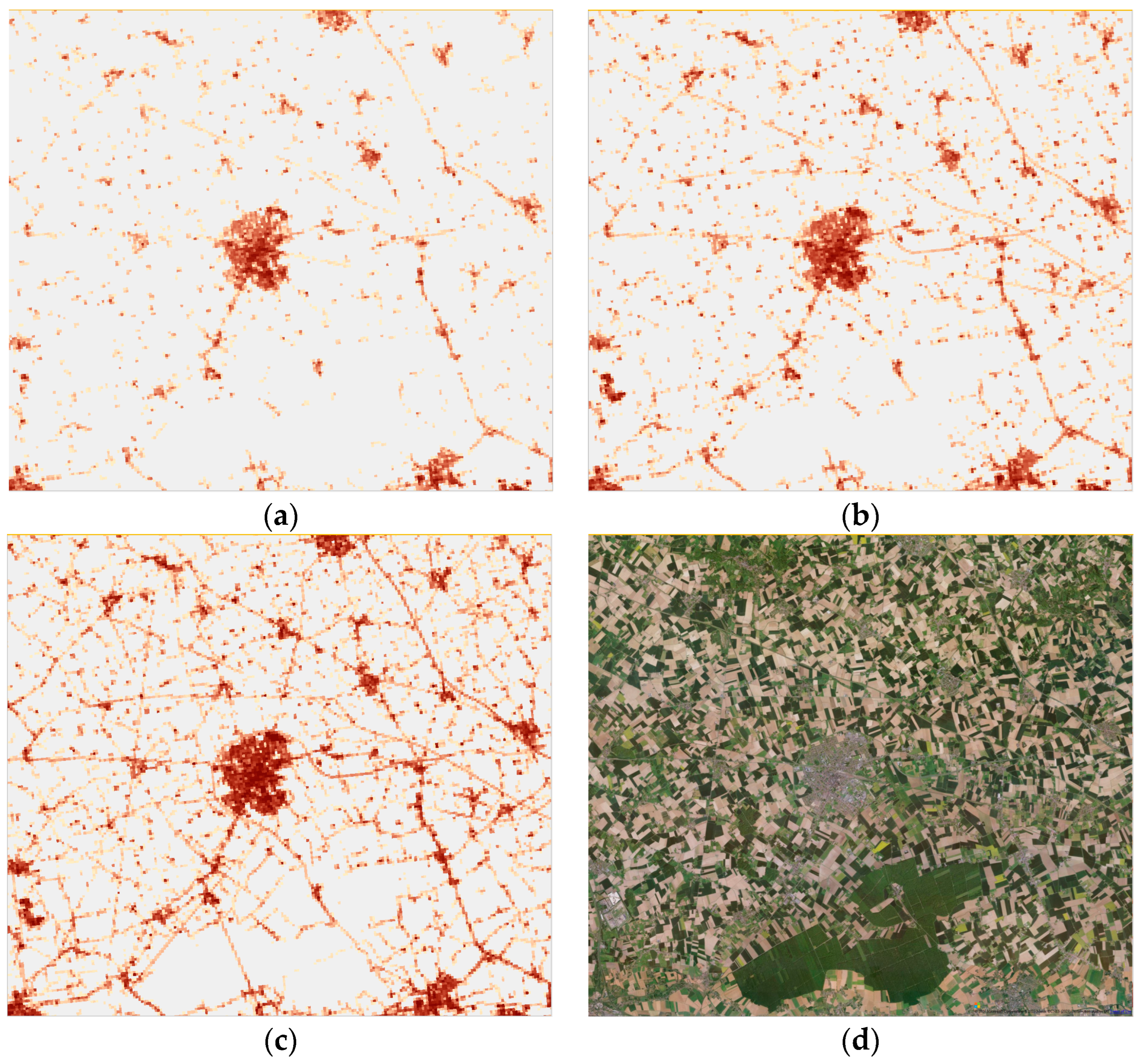


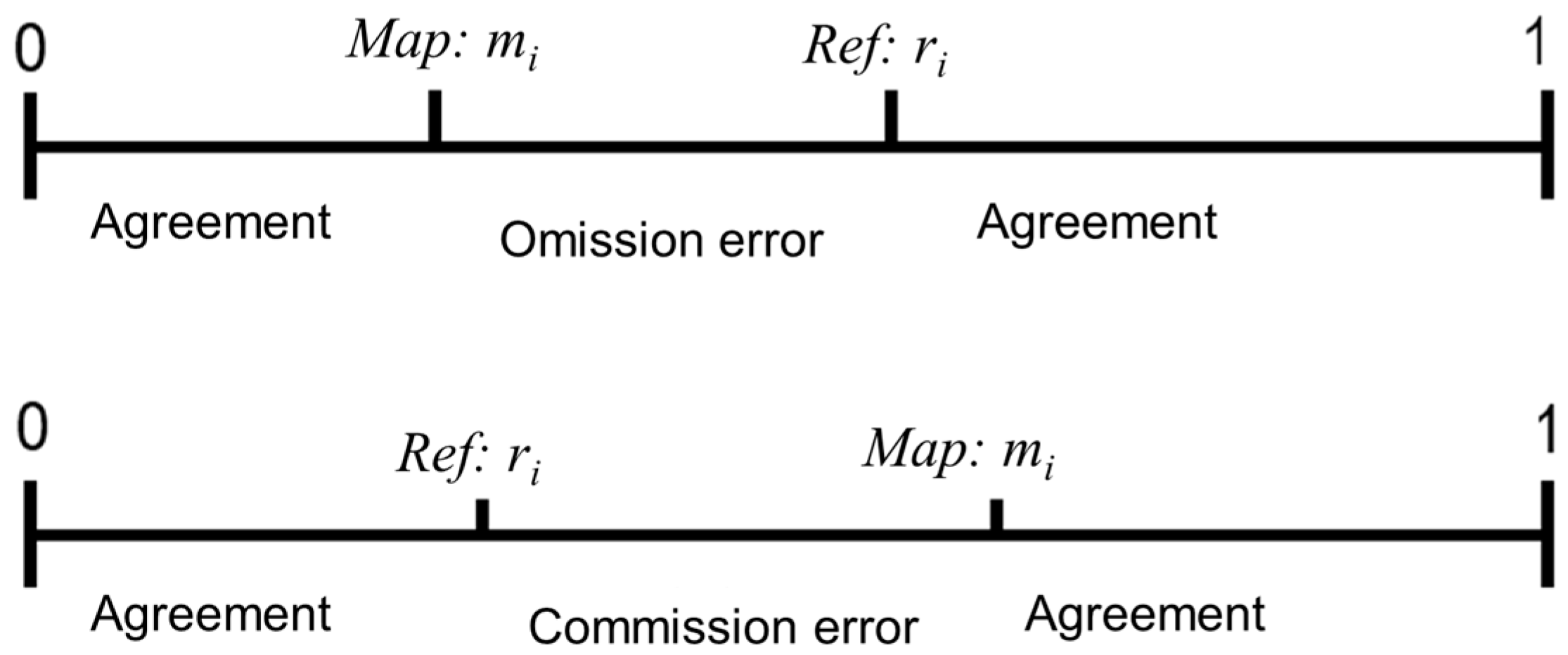
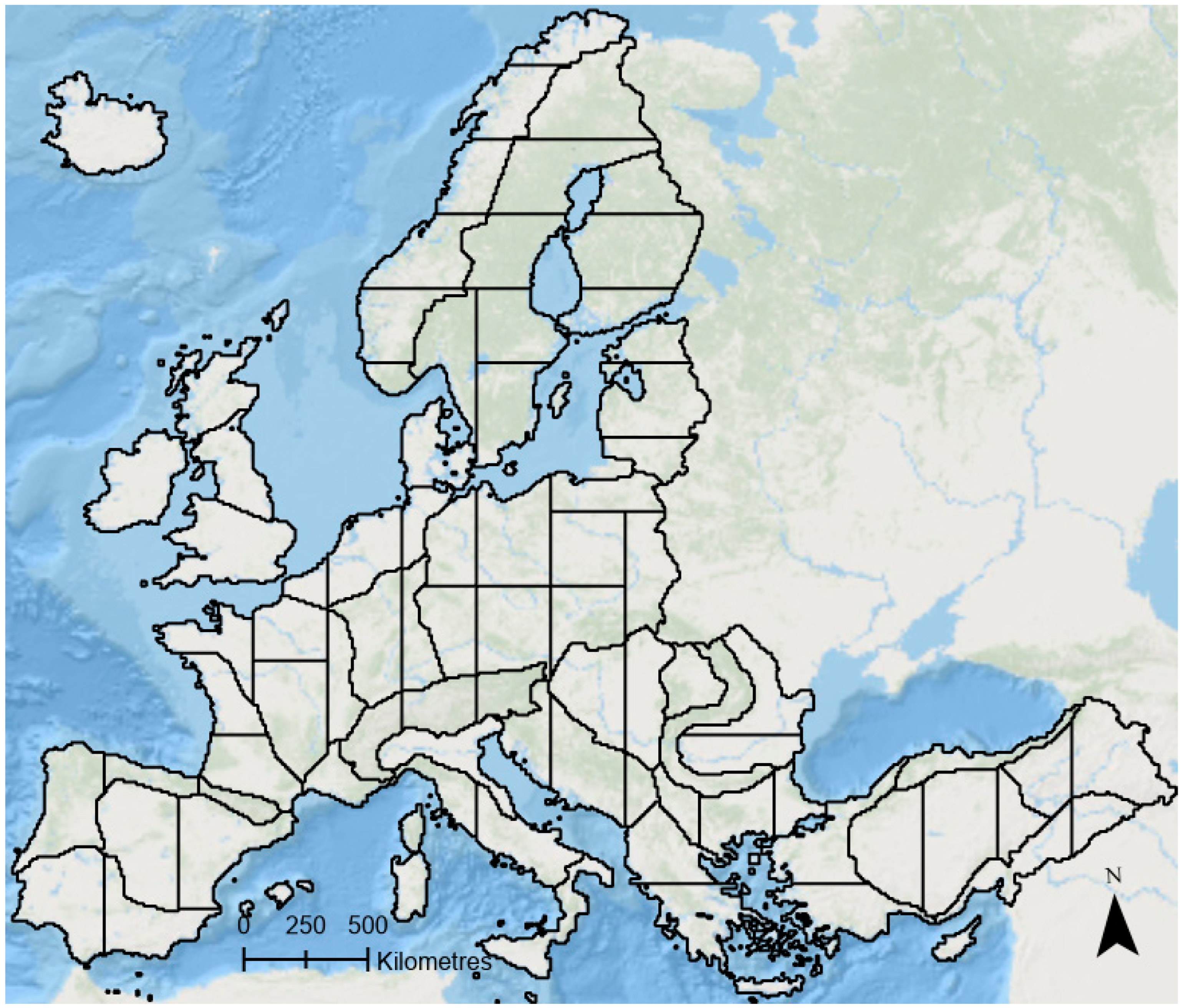
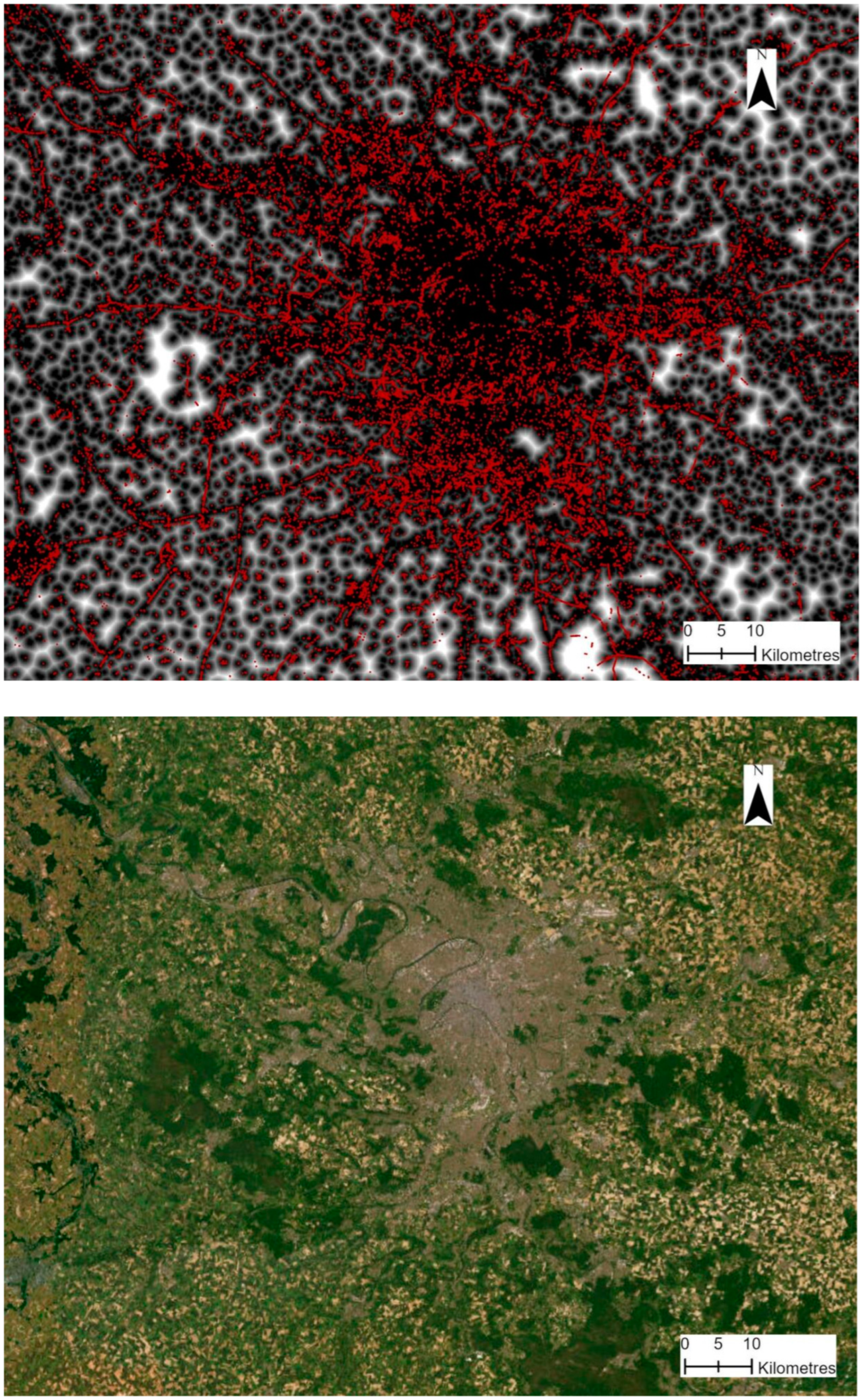


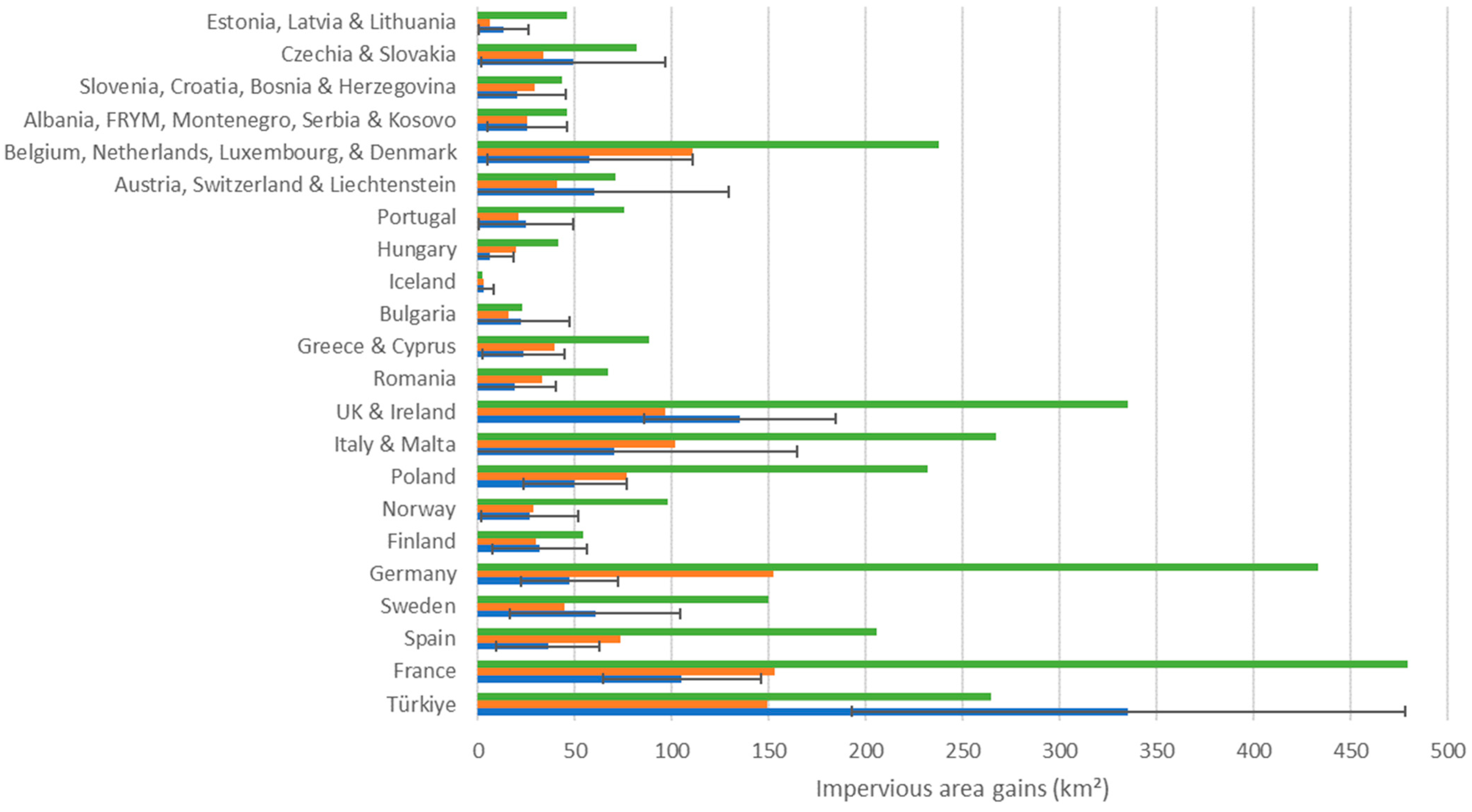
| Area (km2) | 2006 | 2009 | 2012 | 2015 | 2018 |
|---|---|---|---|---|---|
| HRL IMD pixel count estimate | 82,289 | 83,872 | 85,410 | 86,453 | 108,996 |
| CLC+ Backbone pixel count estimate | n/a | n/a | n/a | n/a | 175,664 |
| CLMS validation estimate and 95% confidence interval (CI) | n/a | 158,370 ± 4247 | 159,212 ± 4262 | 161,382 ± 4275 | 160,434 ± 7495 |
| Second CLMS validation estimate and 95% CI | 157,177 ± 4242 | 157,659 ± 4242 | 160,544 ± 4271 | 159,258 ± 7492 | not available |
| Difference with upper/lower limit of 95% CI for IMD | 70,646 | 69,545 | 69,540 | 65,313 | 43,943 |
| Difference with upper/lower limit of 95% CI for CLC + BB | 7735 |
| Area (km2) | 2006–2009 | 2009–2012 | 2012–2015 | 2015–2018 |
|---|---|---|---|---|
| HRL IMCC pixel count estimate | 1715 | 1627 | 1126 | 3808 |
| CLMS validation estimate and 95% confidence interval (CI) | 1197 ± 251 | 1553 ± 509 | 1226 ± 369 | 1176 ± 314 |
| Difference with upper limit of 95% CI | 267 | 0 | 0 | 2318 |
| CLMS IMD | Harmonized Imperiousness Change | ||||||
|---|---|---|---|---|---|---|---|
| RMSE | MAE | MAE > 0 | RMSE | MAE | MAE > 0 | ||
| 2006 | Overall | 4.48 | 1.76 | 37.22 | 3.80 | 1.37 | 8.22 |
| Commission | 0.81 | 0.11 | 2.30 | 2.57 | 0.66 | 3.96 | |
| Omission | 4.40 | 1.65 | 34.92 | 2.80 | 0.71 | 4.27 | |
| Diff Com-Om | −3.59 | −1.54 | −32.63 | −0.24 | −0.05 | −0.31 | |
| 2009 | Overall | 4.46 | 1.75 | 36.57 | 3.82 | 1.37 | 8.17 |
| Commission | 0.82 | 0.11 | 2.30 | 2.60 | 0.67 | 3.99 | |
| Omission | 4.38 | 1.64 | 34.27 | 2.80 | 0.70 | 4.18 | |
| Diff Com-Om | −3.56 | −1.53 | −31.97 | −0.20 | −0.03 | −0.19 | |
| 2012 | Overall | 4.45 | 1.75 | 36.16 | 3.78 | 1.36 | 8.06 |
| Commission | 0.85 | 0.11 | 2.37 | 2.57 | 0.66 | 3.94 | |
| Omission | 4.37 | 1.64 | 33.80 | 2.77 | 0.69 | 4.12 | |
| Diff Com-Om | −3.52 | −1.52 | −31.43 | −0.20 | −0.03 | −0.18 | |
| 2015 | Overall | 4.60 | 1.77 | 36.29 | 3.75 | 1.35 | 8.01 |
| Commission | 0.84 | 0.11 | 2.32 | 2.42 | 0.65 | 3.85 | |
| Omission | 4.52 | 1.66 | 33.97 | 2.86 | 0.70 | 4.16 | |
| Diff Com-Om | −3.68 | −1.55 | −31.65 | −0.44 | −0.05 | −0.32 | |
| 2018 | Overall | 4.13 | 1.60 | 27.64 | 3.50 | 1.27 | 7.84 |
| Commission | 1.07 | 0.15 | 2.65 | 2.09 | 0.56 | 3.47 | |
| Omission | 3.99 | 1.44 | 24.99 | 2.81 | 0.71 | 4.37 | |
| Diff Com-Om | −2.92 | −1.29 | −22.35 | −0.73 | −0.15 | −0.90 | |
| (km2) | 2006 | 2009 | 2012 | 2015 | 2018 |
|---|---|---|---|---|---|
| CLMS IMD pixel count estimate | 82,289 | 83,872 | 85,410 | 86,453 | 108,996 |
| Harmonized sealing time series pixel count | 169,969 | 171,684 | 173,311 | 174,437 | 175,664 |
| CLMS validation estimate and 95% confidence interval (CI) | n/a | 158,370 ± 4247 | 159,212 ± 4262 | 161,382 ± 4275 | 160,434 ± 7495 |
| Second CLMS validation estimate and 95% CI | 157,177 ± 4242 | 157,659 ± 4242 | 160,544 ± 4271 | 159,258 ± 7492 | n/a |
| Status layer blind validation dataset | 170,488 | 171,035 | 172,162 | 174,552 | 181,093 |
| Difference with upper/lower limit of 95% CI for CLMS IMD | 70,646 | 69,545 | 69,540 | 65,313 | 43,943 |
| Difference with upper/lower limit of 95% CI for harmonized imperviousness change | 8550 | 9067 | 9837 | 8780 | 7735 |
| km2 | 2006–2009 | 2009–2012 | 2012–2015 | 2015–2018 |
|---|---|---|---|---|
| CLMS validation | 1197 ± 251 | 1553 ± 509 | 1226 ± 369 | 1176 ± 314 |
| Initial CLC+ BB/IMCC | 1715 | 1626 | 1126 | 3808 |
| Difference with upper limit of 95% confidence interval | 267 | 0 | 0 | 2318 |
| Harmonized imperviousness change | 1716 | 1626 | 1126 | 1297 |
| Difference with upper limit of 95% confidence interval | 267 | 0 | 0 | 0 |
Disclaimer/Publisher’s Note: The statements, opinions and data contained in all publications are solely those of the individual author(s) and contributor(s) and not of MDPI and/or the editor(s). MDPI and/or the editor(s) disclaim responsibility for any injury to people or property resulting from any ideas, methods, instructions or products referred to in the content. |
© 2024 by the authors. Licensee MDPI, Basel, Switzerland. This article is an open access article distributed under the terms and conditions of the Creative Commons Attribution (CC BY) license (https://creativecommons.org/licenses/by/4.0/).
Share and Cite
Sannier, C.; Ivits, E.; Maucha, G.; Maes, J.; Dijkstra, L. Harmonized Pan-European Time Series for Monitoring Soil Sealing. Land 2024, 13, 1087. https://doi.org/10.3390/land13071087
Sannier C, Ivits E, Maucha G, Maes J, Dijkstra L. Harmonized Pan-European Time Series for Monitoring Soil Sealing. Land. 2024; 13(7):1087. https://doi.org/10.3390/land13071087
Chicago/Turabian StyleSannier, Christophe, Eva Ivits, Gergely Maucha, Joachim Maes, and Lewis Dijkstra. 2024. "Harmonized Pan-European Time Series for Monitoring Soil Sealing" Land 13, no. 7: 1087. https://doi.org/10.3390/land13071087





